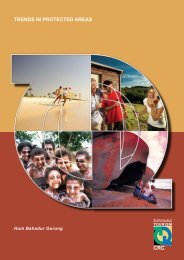icolls - Sustainable Tourism CRC
icolls - Sustainable Tourism CRC
icolls - Sustainable Tourism CRC
You also want an ePaper? Increase the reach of your titles
YUMPU automatically turns print PDFs into web optimized ePapers that Google loves.
ECOLOGY, THREATS AND MANAGEMENT OPTIONS FOR SMALL ESTUARIES AND ICOLLS<br />
ABSTRACT<br />
Over 60% of south-eastern Australia’s coastal waterways can be classified as intermittently closed and open<br />
lakes and lagoons (ICOLLs). At present, very little is known about the recreational use of ICOLLs and how such<br />
use varies geographically and temporally along the New South Wales coast. The impacts of tourism on natural<br />
environments are of increasing concern in Australia, especially in coastal areas, so it is timely that we investigate<br />
ICOLL ecology in conjunction with tourist use patterns to ensure that these systems are appreciated, used<br />
appropriately and managed sustainably.<br />
In comparison with large estuaries, relatively little is known of the ecology of these intermittently open<br />
systems and their responses to perturbations. This lack of knowledge of how these systems respond to<br />
anthropogenic activities threatens their long-term sustainability, particularly in light of the high human<br />
population density in coastal regions of Australia and increasing nutrient inputs from urban (sewage), industrial<br />
and agricultural sources. In addition, local management agencies often artificially alter the opening and closing<br />
regimes of ICOLLs to minimise the aesthetic effects of algal blooms and local flooding. In addition to these<br />
watershed scale perturbations, ICOLLs can be significant sites for recreation and fishing activities in the coastal<br />
zone, yet we know little about the effects of these activities on ICOLL health.<br />
In this study we investigated critical aspects of ICOLL ecology and asked: how do these systems respond to<br />
increasing coastal pressures in general and in particular, those directly or indirectly related to tourism and<br />
recreation in their catchments? We used a variety of mechanisms to tackle this question, ranging from detailed<br />
literature reviews of ICOLL responses to perturbations, to field investigations of ICOLL characteristics and fish<br />
assemblages, food web structure and sources of carbon (energy) fuelling ICOLL productivity. We were<br />
particularly interested in the influence of nutrient inputs (particularly from STPs) and entrance opening and<br />
closing regimes on the basic structure of the food web and in turn, the implications of these modifications for the<br />
sustainability and tourism appeal of ICOLLs. Specifically, we focused on aspects of the fish communities of<br />
ICOLLs, particularly the diets of commercially and recreationally valuable species like Yellowfin Bream<br />
(Acanthopagrus australis), Sand Whiting (Sillago ciliata), Dusky Flathead (Platycephalus fuscus) and Sea<br />
Mullet (Mugil cephalus).<br />
We found that ICOLLs tend to support a wide array of invertebrate and fish taxa and that diversity and the<br />
functioning of ICOLL food webs are strongly influenced by entrance opening and closing regimes. Furthermore,<br />
the diets of valuable fish species tended to be narrower in our study ICOLLs than in larger estuaries, highlighting<br />
dramatically different resource use patterns in these dynamic coastal waterbodies. The sustainability of ICOLLs<br />
for tourism and recreation is increasingly threatened by coastal developments and our research highlights the<br />
importance of maintaining ICOLLs as fish nursery grounds and significant recreational fishing sites along the<br />
Australian coastline.<br />
ACKNOWLEDGEMENTS<br />
The <strong>Sustainable</strong> <strong>Tourism</strong> Cooperative Research Centre, an Australian government initiative, funded this<br />
research.<br />
The Centre for Riverine Landscapes and Griffith University also supported this research through provision of<br />
expertise and equipment required for the field and laboratory work.<br />
The direction and outcomes of the project benefited greatly due to contributions from Professor Leon Zann<br />
(formerly of Southern Cross University), Dr David Rissik (NSW DIPNR now DEC), Chistopher Irons (Griffith<br />
University) and Peter Helman (Southern Cross University). In addition, Grant Russell made major contributions<br />
to the study, particularly the work reported in Chapter 4, during his eight week summer scholarship in the Centre<br />
for Riverine Landscapes at Griffith University.<br />
Field assistance from Grant Russell, Steve Mackay, Kim Markwell, Nerida Beard, Christy Fellows, Andrew<br />
Cook, Kate Smolders, Katrina Goudkemp, Ellie Dores and Kate Lawrance was greatly appreciated. Rene<br />
Diocares provided technical support and ran the stable isotope samples through the Mass Spectrometer.<br />
Laboratory and analytical assistance from Vanessa Fry was also beneficial.<br />
vi











